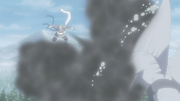The jinchūriki are typically lonely people, viewed by those around them as the tailed beasts that had been sealed within them, leading to prejudice and being hated and feared. According to Akatsuki, the first two jinchūriki they captured loathed humanity, and their villages were in fact glad to be rid of them.[1] However, some jinchūriki refuse to waver, even though they have been shunned, and they eventually earned respect. Such examples include Naruto Uzumaki, Killer B, Yugito Nii, and Gaara.
History
By the time of the formation of the shinobi villages, Hashirama Senju, the First Hokage, used his Wood Release kekkei genkai to capture and give several tailed beasts to the other shinobi villages as peace treaties, in order to stabilise the balance of power between them.[4] The Second Kazekage of Sunagakure was the first to research the jinchūriki, with the other villages following soon after, with hopes to use the beasts as weapons in human hosts, or in Konohagakure's case, keep the beasts from doing harm to their village. In order to prevent the jinchūriki from turning traitor, it is tradition for the host to be selected from the family of the village's own Kage. In this way, the jinchūriki not only has strong ties of loyalty to village and their leader, but they also serve to show off the Kage's might.[5] For example, Gaara is the son of the Fourth Kazekage, and Killer B is the adoptive brother and partner of the Fourth Raikage.
Sealing

It's been shown some sort of compatibility between the tailed beast and the potential jinchūriki is required;[6][7] to become the host of the Ten-Tails, one must be a fully living person, as opposed to having an undead body created by Summoning: Impure World Reincarnation.[8] If the tailed beast is removed from its jinchūriki's body, the jinchūriki will die. Similarly, if the jinchūriki dies with the tailed beast still sealed within them, the beast will die too. Because of this, the tailed beasts tend to be very protective of their jinchūriki, and will take any action whenever their lives are in danger. However, it is revealed that the tailed beasts can actually survive their jinchūriki's deaths, with the only consequence being that it will take time for them to revive without a host.[9][10] Also, rare exceptions of a jinchūriki surviving an extraction may occur, if the said host has high enough stamina.[11]
The seal that keeps the tailed beast within its female jinchūriki is at its weakest when she is in childbirth,[12] due to the nurturing of the child in the womb taking precedence over the reinforcement of the seal, which weakens the seal in direct proportion. As such, a ninja is required to keep the seal intact during childbirth, and restore the seal back to full power afterwards. A full-term pregnancy for a female jinchūriki is about ten months.[13]
Abilities
See also: Tailed Beast Skill
Control
Main article: Tailed Beast Control
List of Jinchūriki
Similar Cases
- When someone possesses the tailed beast's chakra but not the beast itself, that person is considered a pseudo-jinchūriki (人柱力もどき, jinchūrikimodoki; English TV "Simulated-jinchūriki").[20] There have been three successful cases of this thus far:
- At one point during the time of the foundation of the shinobi villages, the Gold and Silver Brothers of Kumogakure were assigned to capture Kurama, but the fox swallowed them whole. However, the two brothers managed to survive and gain some of its power by eating the flesh of its stomach for two weeks, which caused Kurama to regurgitate them.[21] They also had similar facial markings to those of Naruto, something that not even the previous true jinchūriki of Kurama, Mito and Kushina Uzumaki, possessed.[22] An unnamed Kumo-nin also tried to copy their method by eating one of Gyūki's tentacles, but instead of becoming a jinchūriki, he died as a result. It is said that Kinkaku and Ginkaku were "something special" and is stated by the Fourth Raikage that they may be distantly related to the Sage of the Six Paths.[23]
- Minato Namikaze, due to having Kurama's Yin chakra, was able to use a chakra cloak after being reincarnated by Orochimaru.[24]
- In the anime, Sora only had a residual amounts of Kurama's chakra sealed into him, granting him similar abilities to those of a true jinchūriki, though his were vastly inferior. This chakra required a container and was dispersed into nothingness once it was released from Sora's body.
- In the anime, Yūkimaru had the ability to partially control Isobu.[25] Isobu was not actually sealed inside of Yūkimaru however, and thus, he was not a true jinchūriki.
- In the anime, Kabuto Yakushi used his Body Recreation Technique with some of Kurama's chakra in order to create a clone of Naruto's four-tailed form. Proving too powerful for Kabuto's control, the clone is able to siphon Kurama's chakra to temporarily increase his power.[26]
- In Naruto Shippūden 2: Bonds, both Amaru and Shinnō had each tapped into the power of the Zero-Tails at different times, which was sealed within the Land of the Sky; however, because the Zero-Tails is not an actual tailed beast, nor was the creature sealed in either of them, Amaru and Shinnō are not considered jinchūriki.
- In Naruto 5: Blood Prison, Muku, a young boy sacrificed to the Box of Ultimate Bliss, becomes possessed by an evil demon called Satori.
- In Naruto 6: Road to Ninja, Naruto's counterpart in the Genjutsu World, Menma, is the jinchūriki of Kurama's counterpart, the Black Nine-Tails.
- In Naruto Shippūden: Dragon Blade Chronicles, the main antagonist Kuroma Tatsushiro planned to merge with the five Genryū to become the Light Dragon so he can use its power to destroy the world, which Yamato and Naruto thought was similar to becoming a jinchūriki. Later in the game, Akari Tatsushiro instead merged with the Genryū and became the Light Dragon, but was restored to normal by Naruto and the Dragon Blade.



Tidak ada komentar:
Posting Komentar